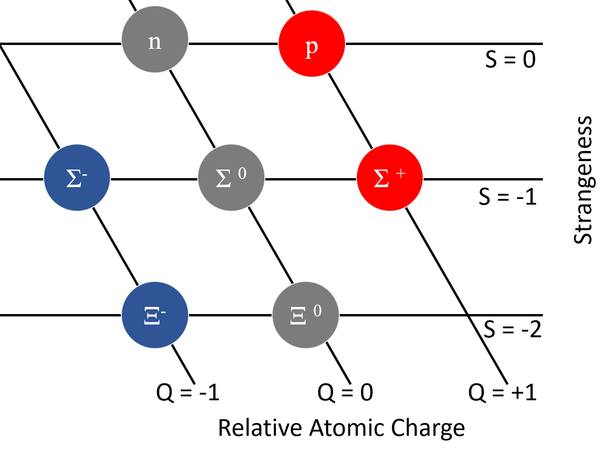Difference between revisions of "Baryon"
(→Determining Baryon Composition) |
(→About Baryons) |
||
| Line 4: | Line 4: | ||
===About Baryons=== | ===About Baryons=== | ||
| − | + | *[[Baryon]]s are part of the larger family of [[particle]]s called [[hadron]]s, which are composed of [[quark]]s held together by the [[Strong Nuclear Interaction|strong force]]. | |
| − | + | *'''Baryons''' include: | |
| − | + | **[[Proton]] - A type of [[baryon]] with a [[mass]] of 1.67x10<sup>-27</sup>kg and a [[Electrical Charge|charge]] of 1.60x10<sup>-19</sup> [[Coulomb]]s, made of 2 [[Up-quark]]s and 1 [[Down-quark]]. | |
| − | + | **[[Neutron]] - A type of [[baryon]] with a [[mass]] of 1.67x10<sup>-27</sup>kg and zero [[Electrical Charge|charge]], made of 2 [[Down-quark]]s and 1 [[Up-quark]]. | |
| + | *There are many other [[baryon]]s made from different groups of [[quark]]s. However, these are unstable and exist only for very short periods of time before [[Radioactive Decay|decaying]] via the [[Weak Nuclear Interaction|weak nuclear interaction]] into other, most stable, [[Subatomic Particle|subatomic particles]]. | ||
: '''Baryons''' are affected by the: | : '''Baryons''' are affected by the: | ||
:*[[Strong Nuclear Interaction]] | :*[[Strong Nuclear Interaction]] | ||
Latest revision as of 12:14, 22 May 2024
Contents
Key Stage 5
Meaning
A baryon is a type of hadron made of three quarks.
About Baryons
- Baryons are part of the larger family of particles called hadrons, which are composed of quarks held together by the strong force.
- Baryons include:
- There are many other baryons made from different groups of quarks. However, these are unstable and exist only for very short periods of time before decaying via the weak nuclear interaction into other, most stable, subatomic particles.
- Baryons are affected by the:
| Baryon | Quark-composition | Charge/e | Strangeness | Baryon Number | Lepton Number |
| \(uud\) | \(Q=+1\) | \(S=0\) | \(B=+1\) | \(L=0\) | |
| \(udd\) | \(Q=0\) | \(S=0\) | \(B=+1\) | \(L=0\) |
Determining Baryon Composition
NB: You only need to memorise the names and quark composition of the proton and the neutron. However, you should be able to determine the quark composition given the charge and strangeness of a given baryon and by remembering the properties of the up-quark, down-quark and strange-quark.
- Baryons can be represented by the following diagram:
| The composition of these baryons can be determined given their charge and strangeness. |
Examples
| Quark | Charge/e | Strangeness |
| \(q=+\frac{2}{3}\) | \(S=0\) | |
| \(q=-\frac{2}{3}\) | \(S=0\) | |
| \(q=-\frac{1}{3}\) | \(S=0\) | |
| \(q=+\frac{1}{3}\) | \(S=0\) | |
| \(q=-\frac{1}{3}\) | \(S=-1\) | |
| \(q=+\frac{1}{3}\) | \(S=+1\) |
| Determine the composition of the Σ+ | Determine the composition of the Ξ- |
|
Σ+ has a strangeness of -1, therefore it contains a strange-quark. \(+1 = -\frac{1}{3} + x + y\) \(+\frac{4}{3} =x + y\) Σ+ has a positive charge. This can be achieved with its strange-quark with a charge of \(-\frac{1}{3}\)e and two quarks with a charge of \(+\frac{2}{3}\)e (an pair of up-quarks). Since \(+1 = -\frac{1}{3} + \frac{2}{3} + \frac{2}{3}\) Therefore \(Σ^+ = s + u + u\) Sigma Baryon = suu |
Ξ- has a strangeness of -2, therefore it contains two strange-quarks. \(-1 = -\frac{1}{3} + -\frac{1}{3} + x\) Ξ- has a negative charge. This can be achieved with its two strange-quarks with a charge of \(-\frac{1}{3}\)e each and another charge of \(-\frac{1}{3}\)e (a down-quark). Since \(-1 = -\frac{1}{3} + -\frac{1}{3} -\frac{1}{3}\) Therefore \(Ξ^- = s + s + d\) Xi Baryon = ssd |
